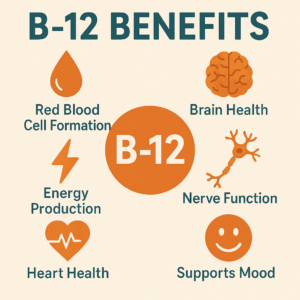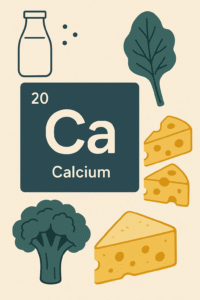When you think about vital nutrients, you might imagine vitamin C for immunity or calcium for strong bones. But there’s one vitamin, often called the “sunshine vitamin,” that is quietly behind the scenes supporting your immune system, mood, energy, and bone health: Vitamin D. Modern science now recognizes that Vitamin D is one of the most important, and most overlooked, keys to optimal wellness.
In this comprehensive guide, we’ll explore what vitamin D is, why it matters, how deficiency can impact your health, how to get enough, and the best ways to supplement—so you can harness the full power of the sunshine vitamin.
What is Vitamin D?
Vitamin D is a fat-soluble vitamin that acts more like a hormone in the body. Unlike most vitamins, your body can make vitamin D on its own—but only when your skin is exposed to sunlight. This unique nutrient is crucial for absorbing calcium and phosphorus, maintaining strong bones, supporting immune function, regulating mood, and even protecting against chronic diseases.
Two Main Forms of Vitamin D:
- Vitamin D2 (ergocalciferol): Found in some plant sources and fortified foods.
- Vitamin D3 (cholecalciferol): Produced by your skin in response to sunlight and found in animal sources. D3 is more effective at raising blood levels of vitamin D.
Why Is Vitamin D So Important?
Vitamin D plays a role in nearly every system in your body. It’s best known for building strong bones, but new research reveals it’s critical for:
- Immune function: Helps your body fight off viruses and infections.
- Mood balance: Low levels are linked with depression and seasonal affective disorder (SAD).
- Energy and muscle strength: Supports neuromuscular function and may reduce fatigue.
- Cardiovascular health: Helps regulate blood pressure and inflammation.
- Reducing risk of chronic disease: Associated with lower rates of certain cancers, diabetes, and autoimmune disorders.
Vitamin D isn’t just another supplement—it’s a wellness powerhouse.
How Common Is Vitamin D Deficiency?
Despite its importance, Vitamin D deficiency is extremely common. It’s estimated that over one billion people worldwide have low levels.
Why is deficiency so widespread?
Poor diet: Few foods naturally contain vitamin D.
Limited sun exposure: Modern indoor lifestyles, sunscreen use, and living in northern latitudes limit the skin’s ability to make vitamin D.
Darker skin: Melanin reduces the skin’s ability to produce vitamin D from sunlight.
Aging: Older adults make less vitamin D from sun and absorb less from food.
Obesity: Vitamin D is fat-soluble and can get trapped in fat tissue.
Signs and Symptoms of Vitamin D Deficiency
Deficiency can be subtle and develop over months or years. Common symptoms include:
- Fatigue and low energy
- Frequent illness or infections
- Bone pain or muscle weakness
- Low mood, irritability, or depression
- Slow wound healing
- Hair loss
- Increased risk of fractures (in older adults)
In children, severe deficiency causes rickets (soft, weak bones), and in adults, it can lead to osteomalacia (bone softening).
Science-Backed Benefits of Vitamin D
Let’s break down the top evidence-based benefits of maintaining optimal vitamin D levels:
1. Stronger Bones and Teeth
Vitamin D helps your body absorb calcium and phosphorus, the building blocks of bone. Without enough, bones become brittle, weak, and prone to fractures.
- Prevents osteoporosis and rickets
- Reduces risk of falls in older adults
2. Boosts Immune Defense
Vitamin D regulates the immune system and helps fight off infections. Studies show that people with low vitamin D are more likely to get colds, flu, and respiratory illnesses.
- Supports production of antimicrobial proteins
- May reduce risk and severity of viral infections
3. Supports Mood and Mental Health
Low vitamin D is associated with depression, especially in winter months. Supplementation may boost mood and help manage seasonal affective disorder (SAD).
4. Enhances Muscle Strength and Energy
Vitamin D is needed for proper muscle contraction and strength. Adequate levels can improve athletic performance, balance, and reduce risk of falls in seniors.
5. May Protect Against Chronic Diseases
Autoimmune support: May reduce risk of MS, type 1 diabetes, and rheumatoid arthritis.
Heart health: Linked to healthy blood pressure and lower risk of heart disease.
Cancer: Some research suggests vitamin D may lower the risk of colorectal, breast, and prostate cancer.
Best Dietary Sources of Vitamin D
Few foods naturally contain vitamin D, so it can be challenging to meet your needs through diet alone.
Top food sources:
- Fatty fish: Salmon, mackerel, sardines, trout, tuna
- Cod liver oil
- Egg yolks
- Fortified milk, plant milks, and orange juice
- Fortified cereals
- Beef liver
- Cheese
- Mushrooms (especially those exposed to sunlight)
Getting Vitamin D from Sunlight
Sunlight is the most natural and efficient way to get vitamin D. Just 10–30 minutes of midday sun exposure on face, arms, and legs a few times a week can be enough for many people.
However, factors like skin color, age, season, latitude, and sunscreen use affect how much vitamin D you can make. In winter or at higher latitudes, your body may not produce any vitamin D from sunlight.
Tip: Don’t overdo sun exposure—protect your skin after you’ve gotten your vitamin D “dose.”
Should You Consider a Vitamin D Supplement?
For many people, especially in winter, a supplement is the easiest and most reliable way to maintain optimal levels.
Who should consider supplementing?
- People who rarely go outside or cover up
- Anyone living north of Atlanta (in the U.S.) or in cloudy climates
- Older adults
- People with darker skin
- Vegans or vegetarians (few plant sources)
- Overweight or obese individuals
Types of Vitamin D Supplements:
- Vitamin D3 (cholecalciferol): The preferred form; more effective at raising blood levels
- Vitamin D2 (ergocalciferol): Still effective but not as potent as D3
How much should you take?
- Recommended Daily Allowance (RDA):
- Adults (19-70 years): 600–800 IU per day
- Older adults (70+): 800–1000 IU per day
Many experts recommend 1,000–2,000 IU per day for adults, especially if you have limited sun exposure. For personalized dosing, a blood test (measuring 25-hydroxyvitamin D) is best.
Note: Vitamin D is fat-soluble—take it with food for best absorption.
Can You Take Too Much Vitamin D?
Yes, high doses over time can be toxic, causing high calcium levels, nausea, vomiting, kidney problems, and more.
Always get your levels checked before taking high doses.
Safe upper limit for adults: 4,000 IU per day unless prescribed higher by a doctor.
Frequently Asked Questions
How do I know if I’m vitamin D deficient?
Blood tests (25-hydroxyvitamin D) are the gold standard. Ask your healthcare provider if you have symptoms or are at risk.
Is it possible to get too much sun for vitamin D?
Yes—excess sun exposure increases skin cancer risk. Get some sun for vitamin D, but always protect your skin.
Are vitamin D2 and D3 the same?
D3 is the preferred and more effective form for most people.
Can I get enough vitamin D from diet alone?
It’s tough. Most people need a combination of food, sunlight, and/or supplements.
How soon will I feel the benefits of vitamin D?
It depends on your starting levels. Some people feel more energetic and notice immune benefits in we
The Bottom Line: Make Vitamin D a Priority in Your Wellness Routine
Vitamin D is far more than just a bone-health nutrient. It supports your immunity, mood, strength, and vitality from the inside out. Given how common deficiency is—especially in winter or for those with limited sun—it’s worth checking your levels and being proactive.
Start today by:
- Spending a little time in the sun (safely)
- Including vitamin D-rich foods in your diet
- Considering a supplement if you’re at risk or can’t get enough naturally
Optimal vitamin D is a simple, science-backed upgrade for your whole-body wellness.
Want more science-backed tips and honest wellness guides? Subscribe to WellnessDoseHub and join our community dedicated to living healthier, naturally!

